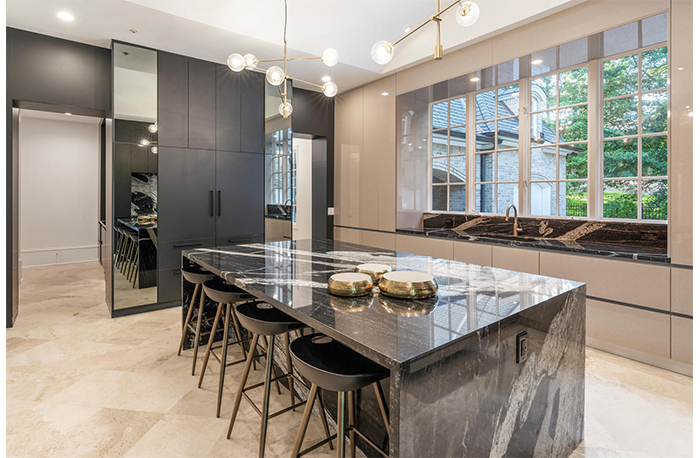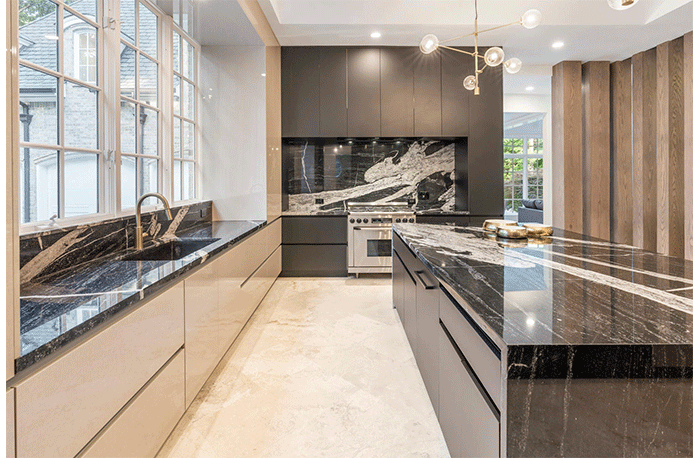European Kitchen Design Influences U.S. Trends

February 19, 2021
America has historically looked to Europe for kitchen design inspiration. At one time, this meant ornate carved wood looks, but now it means a more modern aesthetic. Today, we see the modern European kitchen design trends continuing to influence the American market, injecting sleek lines and glossy finishes into homes across the nation.
Many of the trends we see in modern European design were born from necessity. Because of the space constraints in Europe, there has often been a need to make space look larger by combining two rooms into one supporting multiple purposes. Because of this, modern European design is deeply rooted in clean lines and creative storage solutions to avoid visual clutter and carefully selected color schemes to add depth.
“While American kitchens were typically built as utility spaces, European kitchens were often an extension of the living room and added to the home’s gathering space,” says Maximilian Deitermann, an Atlanta-based real estate developer and interior designer.
We see much of this European kitchen design influence in American design today, including the use of flat panels as opposed ornately carved materials, the trend of hidden appliances, as well as the use of color and mix of materials to inspire depth and warmth.

This and top photo by www.goldlensmedia.com/www.instagram.com/atlanta_photographer
Influenced by Environmental Responsibility
Europeans were among the first to use alternative materials, as this was an environmentally sound approach to design. Largely, designers abandoned the popular solid hardwoods of the past and embraced new looks. The introduction of these materials in the American market opened up many possibilities, including the incorporation of colors and patterns too difficult or costly to acquire in nature.
“More and more people are gravitating toward grays and blacks,” said Kevin McDonald, VP of sales, ALVIC USA, the American arm of a panel innovator originating in Europe. “Another trend we see is the use of wood imitations that have very straight grain, as these patterns echo exotic woods that generally cannot be sustainably farmed. They give kitchens a fresh and unique look.”
Alternative materials are becoming increasingly popular, as the products allow designers to both experiment with new colors and textures but also achieve the look of very rare woods and higher-end materials, such as textiles, carbon fiber and metallic effects.
Benefits of Panel Use
Mixing colors, textures and finishes in kitchen spaces is another way to create the illusion of depth that European designers so often seek.
“We see more American designers experimenting with these looks, often combining solid colors with wood textures,” said Deitermann.
One way to easily achieve this look is by using panels.
“Europeans pioneered frameless cabinetry,” said McDonald. “The design was scale-able and allowed for easy installation, leading to an open, sleek aesthetic. Designers can easily add on panels to create a new look without changing the functionality of cabinetry.”
According to Deitermann, because panels are easily manipulated, designers can alter full panels as well as edge treatments, adding accents and incorporating a touch of color.
Panels are also able to be used creatively in applications beyond cabinetry: wall panels, barn doors, fireplace mantels, staircases and more. Because of their durability and innovative finishes, panels are resistant to staining and fading.
“The kitchen industry has long had difficulty with stability,” said McDonald. “No matter how wood is finished, it is not stable. Older alternative materials like the early thermofoils tended to fade or yellow over time, but newer alternative materials are often UV-cured or have specialized coating chemistry, allowing them to remain stable for years.”
Panels are also highly scratch resistant.
“We are always working to find a balance between aesthetic and durability,” said McDonald. “Alternative material panels allow designers to find this balance like nothing else can, offering endless possibilities.”
More News
April 19, 2024 | Business
How K&B Brands Handle Product Quality Control
April 19, 2024 | Business
Artistic Tile Paramus Unveils New Location
April 18, 2024 | Business, People
Excelling at Kitchen Design When You Don’t Like to Cook
April 18, 2024 | Awards & Events
KCMA Design Awards Announces Winners
April 17, 2024 | People
WAC Lighting Promotes Becky Li to President
April 2, 2024 | Sponsored
Whirlpool Corp. Brings Purposeful Innovation Home